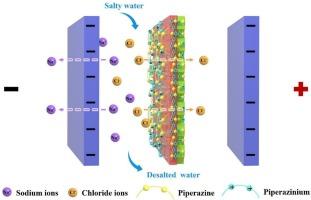Ultrathin asymmetric porous anion exchange membranes for high-efficiency electrodialysis desalination
IF 4.3
2区 工程技术
Q2 ENGINEERING, CHEMICAL
引用次数: 0
Abstract
Freshwater scarcity has intensified the demand for energy-efficient desalination technologies. Among these, electrodialysis (ED) heavily depends on anion exchange membranes (AEMs) that exhibit low resistance and high permselectivity. However, conventional dense AEMs often suffer from thick structures and limited ion transport. This paper presents a structurally tunable ultrathin porous crosslinked AEM based on brominated poly(phenylene oxide) (BPPO). A non-solvent induced phase separation (NIPS) method is used to construct an asymmetric porous framework. Subsequent in situ crosslinking with piperazine and cationization with 1, 2-dimethylpiperazine stabilize the structure and introduce fixed piperazinium groups. The architecture combines high free volume for rapid counter-ion transport with sealed pores and a crosslinking network to suppress co-ion leakage. The membrane microstructure and electrochemical properties can be precisely tuned by adjusting the crosslinking duration. The optimized CCPPO-4 h membrane, with an ultrathin selective layer of only 0.84 μm, exhibits excellent desalination performance. Compared to the commercial AMV AEM, CCPPO-4 h achieves 24.5 % lower energy consumption (1.76 kWh kg−1) and 15.4 % higher current efficiency (89.95 %). This work demonstrates the promise of tunable ultrathin porous AEMs fabricated via scalable processes for next-generation low-energy ED desalination.


超薄不对称多孔阴离子交换膜用于高效电渗析脱盐
淡水短缺加剧了对节能海水淡化技术的需求,其中电渗析(ED)严重依赖于具有低阻力和高选择性的阴离子交换膜(AEMs)。然而,传统的致密AEMs通常存在结构较厚和离子传输受限的问题。介绍了一种结构可调的溴化聚苯乙烯氧化物(BPPO)超薄多孔交联AEM。采用非溶剂诱导相分离(NIPS)法制备了非对称多孔结构。随后与哌嗪原位交联和1,2 -二甲基哌嗪阳离子化稳定了结构并引入了固定的哌嗪基团。该结构结合了用于快速反离子传输的高自由体积、密封孔隙和抑制离子泄漏的交联网络。通过调节交联时间可以精确调节膜的微观结构和电化学性能。优化后的CCPPO-4 h膜具有0.84 μm的超薄选择层,具有优异的脱盐性能。与商用AMV AEM相比,CCPPO-4 h的能耗降低24.5% % (1.76 kWh kg - 1),电流效率提高15.4% %(89.95 %)。这项工作表明,通过可扩展工艺制造的可调谐超薄多孔AEMs有望用于下一代低能耗ED脱盐。
本文章由计算机程序翻译,如有差异,请以英文原文为准。
求助全文
约1分钟内获得全文
求助全文
来源期刊

Chemical Engineering Science
工程技术-工程:化工
CiteScore
7.50
自引率
8.50%
发文量
1025
审稿时长
50 days
期刊介绍:
Chemical engineering enables the transformation of natural resources and energy into useful products for society. It draws on and applies natural sciences, mathematics and economics, and has developed fundamental engineering science that underpins the discipline.
Chemical Engineering Science (CES) has been publishing papers on the fundamentals of chemical engineering since 1951. CES is the platform where the most significant advances in the discipline have ever since been published. Chemical Engineering Science has accompanied and sustained chemical engineering through its development into the vibrant and broad scientific discipline it is today.
 求助内容:
求助内容: 应助结果提醒方式:
应助结果提醒方式:


